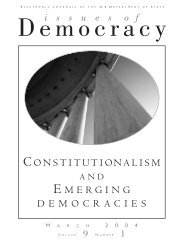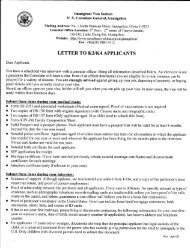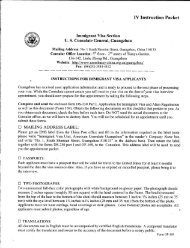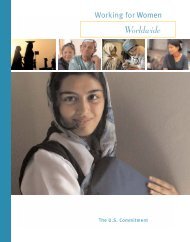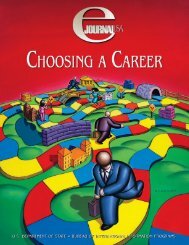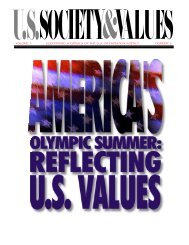s. history us history us history - Embassy of the United States
s. history us history us history - Embassy of the United States
s. history us history us history - Embassy of the United States
- No tags were found...
Create successful ePaper yourself
Turn your PDF publications into a flip-book with our unique Google optimized e-Paper software.
CHAPTER 2: THE COLONIAL PERIODOUTLINE OF U.S. HISTORY<strong>the</strong> New York region long after <strong>the</strong>fall <strong>of</strong> New Ne<strong>the</strong>rland and <strong>the</strong>irintegration into <strong>the</strong> British colonialsystem. Their sharp-stepped gablero<strong>of</strong>s became a permanent part <strong>of</strong><strong>the</strong> city’s architecture, and <strong>the</strong>irmerchants gave Manhattan much<strong>of</strong> its original b<strong>us</strong>tling, commercialatmosphere.THE SOUTHERN COLONIESIn contrast to New England and<strong>the</strong> middle colonies, <strong>the</strong> Sou<strong>the</strong>rncolonies were predominantly ruralsettlements.By <strong>the</strong> late 17th century, Virginia’sand Maryland’s economic andsocial structure rested on <strong>the</strong> greatplanters and <strong>the</strong> yeoman farmers.The planters <strong>of</strong> <strong>the</strong> Tidewater region,supported by slave labor, held most<strong>of</strong> <strong>the</strong> political power and <strong>the</strong> bestland. They built great ho<strong>us</strong>es, adoptedan aristocratic way <strong>of</strong> life, andkept in touch as best <strong>the</strong>y could with<strong>the</strong> world <strong>of</strong> culture overseas.The yeoman farmers, who workedsmaller tracts, sat in popular assembliesand found <strong>the</strong>ir way into political<strong>of</strong>fice. Their outspoken independencewas a constant warning to <strong>the</strong>oligarchy <strong>of</strong> planters not to encroachtoo far upon <strong>the</strong> rights <strong>of</strong> free men.The settlers <strong>of</strong> <strong>the</strong> Carolinasquickly learned to combine agricultureand commerce, and <strong>the</strong>marketplace became a major source<strong>of</strong> prosperity. Dense forests broughtrevenue: Lumber, tar, and resinfrom <strong>the</strong> longleaf pine providedsome <strong>of</strong> <strong>the</strong> best shipbuilding materialsin <strong>the</strong> world. Not bound toa single crop as was Virginia, Northand South Carolina also producedand exported rice and indigo, a bluedye obtained from native plants thatwas <strong>us</strong>ed in coloring fabric. By 1750more than 100,000 people lived in<strong>the</strong> two colonies <strong>of</strong> North and SouthCarolina. Charleston, South Carolina,was <strong>the</strong> region’s leading port andtrading center.In <strong>the</strong> sou<strong>the</strong>rnmost colonies, aseverywhere else, population growthin <strong>the</strong> backcountry had special significance.German immigrants andScots-Irish, unwilling to live in<strong>the</strong> original Tidewater settlementswhere English influence was strong,p<strong>us</strong>hed inland. Those who could notsecure fertile land along <strong>the</strong> coast, orwho had exha<strong>us</strong>ted <strong>the</strong> lands <strong>the</strong>yheld, found <strong>the</strong> hills far<strong>the</strong>r westa bountiful refuge. Although <strong>the</strong>irhardships were enormo<strong>us</strong>, restlesssettlers kept coming; by <strong>the</strong> 1730s<strong>the</strong>y were pouring into <strong>the</strong> ShenandoahValley <strong>of</strong> Virginia. Soon <strong>the</strong>interior was dotted with farms.Living on <strong>the</strong> edge <strong>of</strong> NativeAmerican country, frontier familiesbuilt cabins, cleared <strong>the</strong> wilderness,and cultivated maize and wheat.The men wore lea<strong>the</strong>r made from<strong>the</strong> skin <strong>of</strong> deer or sheep, knownas buckskin; <strong>the</strong> women wore garments<strong>of</strong> cloth <strong>the</strong>y spun at home.Their food consisted <strong>of</strong> venison,wild turkey, and fish. They had <strong>the</strong>irown am<strong>us</strong>ements: great barbecues,dances, ho<strong>us</strong>ewarmings for newlymarried couples, shooting matches,and contests for making quiltedblankets. Quilt-making remains anAmerican tradition today.SOCIETY, SCHOOLS, ANDCULTUREA significant factor deterring <strong>the</strong>emergence <strong>of</strong> a powerful aristocraticor gentry class in <strong>the</strong> colonies was<strong>the</strong> ability <strong>of</strong> anyone in an establishedcolony to find a new homeon <strong>the</strong> frontier. Time after time,dominant Tidewater figures wereobliged to liberalize political policies,land-grant requirements, andreligio<strong>us</strong> practices by <strong>the</strong> threat <strong>of</strong> amass exod<strong>us</strong> to <strong>the</strong> frontier.Of equal significance for <strong>the</strong>future were <strong>the</strong> foundations <strong>of</strong>American education and cultureestablished during <strong>the</strong> colonial period.Harvard College was foundedin 1636 in Cambridge, Massach<strong>us</strong>etts.Near <strong>the</strong> end <strong>of</strong> <strong>the</strong> century,<strong>the</strong> College <strong>of</strong> William and Marywas established in Virginia. A fewyears later, <strong>the</strong> Collegiate School <strong>of</strong>Connecticut, later to become YaleUniversity, was chartered.Even more noteworthy was <strong>the</strong>growth <strong>of</strong> a school system maintainedby governmental authority.The Puritan emphasis on readingdirectly from <strong>the</strong> Scriptures underscored<strong>the</strong> importance <strong>of</strong> literacy. In1647 <strong>the</strong> Massach<strong>us</strong>etts Bay Colonyenacted <strong>the</strong> “ye olde deluder Satan”Act, requiring every town havingmore than 50 families to establisha grammar school (a Latin schoolto prepare students for college).Shortly <strong>the</strong>reafter, all <strong>the</strong> o<strong>the</strong>r NewEngland colonies, except for RhodeIsland, followed its example.The Pilgrims and Puritans hadbrought <strong>the</strong>ir own little librariesand continued to import booksfrom London. And as early as <strong>the</strong>1680s, Boston booksellers were doinga thriving b<strong>us</strong>iness in works <strong>of</strong>classical literature, <strong>history</strong>, politics,philosophy, science, <strong>the</strong>ology, andbelles-lettres. In 1638 <strong>the</strong> first printingpress in <strong>the</strong> English colonies and<strong>the</strong> second in North America wasinstalled at Harvard College.The first school in Pennsylvaniawas begun in 1683. It taught reading,writing, and keeping <strong>of</strong> accounts.Thereafter, in some fashion, everyQuaker community provided for <strong>the</strong>elementary teaching <strong>of</strong> its children.More advanced training — in classicallanguages, <strong>history</strong>, and literature— was <strong>of</strong>fered at <strong>the</strong> Friends PublicSchool, which still operates in Philadelphiaas <strong>the</strong> William Penn CharterSchool. The school was free to <strong>the</strong>poor, but parents were required topay tuition if <strong>the</strong>y were able.In Philadelphia, numero<strong>us</strong> privateschools with no religio<strong>us</strong> affiliationtaught languages, ma<strong>the</strong>matics,and natural science; <strong>the</strong>re werealso night schools for adults. Womenwere not entirely overlooked, but<strong>the</strong>ir educational opportunities werelimited to training in activities thatcould be conducted in <strong>the</strong> home.Private teachers instructed <strong>the</strong>daughters <strong>of</strong> prospero<strong>us</strong> Philadelphiansin French, m<strong>us</strong>ic, dancing,painting, singing, grammar, andsometimes bookkeeping.2627



